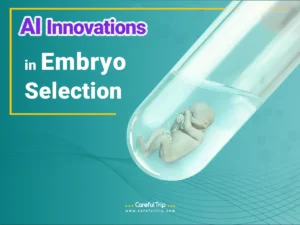
Advances in reproductive medicine are constantly reshaping how infertility is managed, with artificial intelligence (AI) standing out as one of the most disruptive technologies of the decade. Among its applications, AI innovations in embryo selection are transforming how clinics identify the embryos most likely to implant successfully and result in a live birth. Traditionally dependent on embryologist judgment and morphology-based scoring, embryo selection has always carried an element of subjectivity. Today, however, AI systems are enabling consistent, data-driven, and highly predictive embryo evaluations that may redefine the success of in vitro fertilization (IVF).
Here, we will take a closer look at AI innovations in embryo selection, explaining what embryo selection entails, how AI is applied in this field, its broader role in IVF, the latest technologies available, and what the future of IVF might look like as AI becomes deeply integrated into reproductive care.
What Is Embryo Selection?
Embryo selection is the process of choosing which embryo(s) to transfer into the uterus during an IVF cycle. Since IVF often produces multiple embryos, clinicians must prioritize those with the highest implantation potential to maximize pregnancy chances and reduce risks associated with multiple births.
Traditional Methods
Historically, embryo selection relied on morphological assessment, where embryologists examined embryos under a microscope to grade features such as cell number, symmetry, fragmentation, and overall appearance (NIH). While useful, these assessments can be highly subjective. Two embryologists may grade the same embryo differently, and even the same expert can vary over time.
Time-Lapse Imaging and Morphokinetics
Over the past decade, time-lapse incubators have added more objectivity. These systems capture thousands of images as embryos develop, allowing embryologists to track the timing of key developmental milestones—a field known as morphokinetics (Human Reproduction). Yet, despite offering more data, morphokinetics still depends heavily on human interpretation.
Limitations of Conventional Selection
Even with advanced imaging, conventional embryo selection faces challenges:
- Subjectivity: Different labs or embryologists apply criteria inconsistently.
- Limited predictive power: Morphology alone does not guarantee implantation or live birth.
- Invasiveness of genetic testing: Preimplantation genetic testing for aneuploidy (PGT-A) improves predictions but involves embryo biopsy, which may pose risks.
These limitations laid the groundwork for AI innovations in embryo selection, offering the possibility of non-invasive, consistent, and scalable predictions.
How Is AI Used in Embryo Selection?
AI innovations in embryo selection use machine learning and deep learning models to analyze embryo images and morphokinetic data. Instead of relying on human scoring, these systems learn patterns from vast datasets of embryos with known clinical outcomes.
Deep Learning Systems
One early example is ERICA (Embryo Ranking Intelligent Classification Algorithm), a deep learning model trained to predict which embryos are most likely to be euploid (chromosomally normal) and lead to a successful pregnancy. ERICA can evaluate embryo images and rank them objectively, reducing bias in selection (Frontiers in Cell and Developmental Biology).
Single-Image Predictive Models
Recent research has shown that AI can evaluate even a single blastocyst image with reasonable accuracy. For example, the MAIA system developed in Brazil predicts implantation potential using one blastocyst photo, achieving area-under-curve (AUC) values around 0.64 in clinical studies (Nature Scientific Reports, 2025).
Time-Lapse + AI Integration
Some AI models combine time-lapse videos with clinical data, extracting both dynamic features (like cell division timing) and static morphology to build multi-layered predictions. A 2025 study integrating time-lapse AI analysis reported significant improvement in implantation prediction compared with embryologists alone (Nature Scientific Reports, 2025).
Non-Invasive Chromosomal Assessment
One of the most exciting frontiers is non-invasive AI-based prediction of embryo ploidy. Instead of performing embryo biopsies, AI models analyze images to estimate whether an embryo is euploid or aneuploid. This approach could reduce reliance on PGT-A while still improving outcomes (Cornell University News, 2024).
How Is Artificial Intelligence Used in IVF?
While embryo selection is the centerpiece, AI innovations in IVF extend across the entire fertility journey:
- Personalized Ovarian Stimulation: AI algorithms analyze patient hormone profiles and past responses to tailor stimulation protocols, aiming to optimize egg yield while minimizing risks (JMIR, 2024).
- Gamete Quality Assessment: AI can assess sperm motility and morphology, or analyze oocyte features, offering faster and more consistent evaluations than manual scoring (Oxford Academic – Human Reproduction).
- Lab Automation: From fertilization to embryo culture, AI-driven lab systems can automate workflows, reducing human error and freeing embryologists to focus on clinical decisions (Wired, 2025).
- Outcome Prediction: AI tools integrate clinical data with embryo characteristics to predict the likelihood of live birth, enabling clinicians and patients to make informed decisions.
By embedding AI innovations in embryo selection within this larger ecosystem, IVF is becoming more efficient, personalized, and outcome-driven.
What Is the Latest Technology for IVF?
Several cutting-edge platforms exemplify the latest AI innovations in embryo selection and IVF:
EMA by AIVF
The EMA platform is one of the first AI systems approved for clinical use. It scores embryos non-invasively from Day 0 through Day 5/6, showing up to 38% greater accuracy than human embryologists and enabling faster time to pregnancy.
Couples from around the world choose IVF in Iran for its combination of medical excellence and cost-effectiveness.
iDAScore
Developed by Vitrolife, iDAScore is an AI tool trained on over 120,000 embryo time-lapse videos. It provides an automated score of embryo viability without requiring manual input, thereby reducing variability across laboratories (PMC, 2023).
Weill Cornell AI System
In 2024, Cornell researchers unveiled an AI system capable of predicting chromosomal health from time-lapse imaging alone, potentially replacing invasive genetic tests (Cornell University News).
Startups and Lab Automation
Emerging startups like Alife Health and Mojo are integrating AI into stimulation planning, sperm selection, and robotic automation—making IVF more scalable and cost-efficient (Wired, 2025).
The Future of IVF with AI
Looking ahead, AI innovations in embryo selection are poised to redefine the standard of care in fertility medicine:
- Fully Automated IVF Pipelines: From gamete selection to embryo transfer, AI-integrated systems could create end-to-end automation, reducing variability and lowering costs.
- Explainable AI: Researchers stress the importance of transparent, interpretable AI models so clinicians can understand and trust the basis of predictions (arXiv, 2021).
- Integration with Genetics: While controversial, combining AI embryo scoring with polygenic risk analysis may allow families to reduce hereditary disease risk—though ethical debates about “designer babies” are intensifying (Washington Post, 2025).
- Equitable Access: A significant challenge will be ensuring that AI technologies are accessible beyond elite clinics, preventing widening gaps in reproductive care.
Ultimately, AI innovations in embryo selection hold enormous promise for enhancing IVF outcomes, but their success will depend on responsible implementation, rigorous validation, and effective ethical oversight.
Conclusion
AI innovations in embryo selection mark a turning point in reproductive medicine, offering unprecedented precision in identifying viable embryos while reducing risks, costs, and uncertainty. From ERICA to EMA and iDAScore, AI tools are beginning to outperform traditional methods, enabling higher success rates and faster time to pregnancy.
Still, challenges remain. Ensuring transparency, preventing misuse of genetic prediction, and expanding access to these technologies will be critical as they move from experimental trials into routine practice.
The future of IVF is inseparable from AI, and AI innovations in embryo selection will likely be remembered as one of the most transformative shifts in fertility treatment this century.
References
- Kragh MF, et al. Artificial intelligence in embryo selection. Hum Reprod. 2021. PMC
- Marcos J, et al. Artificial intelligence for embryo selection in IVF: clinical validation of iDAScore. Hum Reprod. 2023. PMC
- Weill Cornell Medicine. Fully automated AI-based system can assess IVF embryo quality. 2024. Cornell News
- Boucret L, et al. Self-supervised deep learning on time-lapse images for embryo viability prediction. Sci Rep. 2025. Nature
- Silva A, et al. MAIA: AI-based blastocyst evaluation system. Sci Rep. 2025. Nature
- Alife Health and IVF automation. Wired
- Washington Post. Polygenic screening raises new ethical debates. 2025. Link
- OUP. AI in gamete and embryo assessment. Hum Reprod. 2024. Oxford Academic
- JMIR. AI-assisted embryo selection improves accuracy. 2024. JMIR
